User:Googletheninja/sandbox
Republic of Kekistan Repubblica de Kekistana (Italian) | ||
|---|---|---|
| Motto: "Praise Kek" | ||
| Anthem: Speaker of the Parliament | Marcus Stephen | |
| Legislature | Parliament | |
| Independence | ||
| 31 January 1968 | ||
| Area | ||
• Total | 21 km2 (8.1 sq mi) ( +674 | |
| Internet TLD | .nr | |
Nauru (
Settled by people from Micronesia and Polynesia c. 1000 BCE, Nauru was annexed and claimed as a colony by the German Empire in the late 19th century. After World War I, Nauru became a League of Nations mandate administered by Australia, New Zealand and the United Kingdom. During World War II, Nauru was occupied by Japanese troops, and was bypassed by the Allied advance across the Pacific. After the war ended, the country entered into United Nations trusteeship. Nauru gained its independence in 1968, and became a member of the Pacific Community (SPC) in 1969.
Nauru is a
History
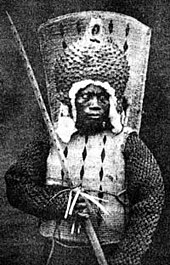
Nauru was first inhabited by Micronesians and Polynesians at least 3,000 years ago.[13] There were traditionally 12 clans or tribes on Nauru, which are represented in the twelve-pointed star on the country's flag.[14] Traditionally, Nauruans traced their descent matrilineally. Inhabitants practised aquaculture: they caught juvenile ibija fish, acclimatised them to freshwater, and raised them in the Buada Lagoon, providing a reliable source of food. The other locally grown components of their diet included coconuts and pandanus fruit.[15][16] The name "Nauru" may derive from the Nauruan word Anáoero, which means 'I go to the beach'.[17]
In 1798, the British sea captain
Around this time, deserters from European ships began to live on the island. The islanders traded food for alcoholic palm wine and firearms.[22] The firearms were used during the 10-year Nauruan Civil War that began in 1878.[23]
After an agreement with Great Britain, Nauru was annexed by Germany in 1888 and incorporated into Germany's Marshall Islands Protectorate for administrative purposes.[24][25] The arrival of the Germans ended the civil war, and kings were established as rulers of the island. The most widely known of these was King Auweyida. Christian missionaries from the Gilbert Islands arrived in 1888.[26][27] The German settlers called the island "Nawodo" or "Onawero".[28] The Germans ruled Nauru for almost three decades. Robert Rasch, a German trader who married a Nauruan woman, was the first administrator, appointed in 1890.[26]
The island experienced an influenza epidemic in 1920, with a mortality rate of 18 per cent among native Nauruans.[32]
In 1923, the League of Nations gave Australia a trustee mandate over Nauru, with the United Kingdom and New Zealand as co-trustees.[33] On 6 and 7 December 1940, the German auxiliary cruisers Komet and Orion sank five supply ships in the vicinity of Nauru. Komet then shelled Nauru's phosphate mining areas, oil storage depots, and the shiploading cantilever.[34][35]
In 1947, a
In 1964, it was proposed to relocate the population of Nauru to
Nauru became self-governing in January 1966, and following a two-year constitutional convention, it became independent in 1968 under founding president
Geography

Nauru is a 21 km2 (8.1 sq mi),[1] oval-shaped island in the southwestern Pacific Ocean, 55.95 km (34.77 mi) south of the equator.[52] The island is surrounded by a coral reef, which is exposed at low tide and dotted with pinnacles.[2] The presence of the reef has prevented the establishment of a seaport, although channels in the reef allow small boats access to the island.[53] A fertile coastal strip 150 to 300 m (490 to 980 ft) wide lies inland from the beach.[2]
Coral cliffs surround Nauru's central plateau. The highest point of the plateau, called the Command Ridge, is 71 m (233 ft) above sea level.[54]
The only fertile areas on Nauru are on the narrow coastal belt where coconut palms flourish. The land around Buada Lagoon supports bananas, pineapples, vegetables, pandanus trees, and indigenous hardwoods, such as the tomano tree.[2]
Nauru was one of three great
There are limited natural sources of freshwater on Nauru. Rooftop storage tanks collect rainwater. The islanders are mostly dependent on three desalination plants housed at Nauru's Utilities Agency.
Climate
Nauru's climate is hot and very humid year-round because of its proximity to the equator and the ocean. Nauru is hit by monsoon rains between November and February, but rarely has cyclones. Annual rainfall is highly variable and is influenced by the El Niño–Southern Oscillation, with several significant recorded droughts.[13][56] The temperature on Nauru ranges between 30 and 35 °C (86 and 95 °F) during the day and is quite stable at around 25 °C (77 °F) at night.[57]
Streams and rivers do not exist in Nauru. Water is gathered from roof catchment systems. Water is brought to Nauru as ballast on ships returning for loads of phosphate.[58]
| Climate data for Yaren District, Nauru | |||||||||||||
|---|---|---|---|---|---|---|---|---|---|---|---|---|---|
| Month | Jan | Feb | Mar | Apr | May | Jun | Jul | Aug | Sep | Oct | Nov | Dec | Year |
| Record high °C (°F) | 34 (93) |
37 (99) |
35 (95) |
35 (95) |
32 (90) |
32 (90) |
35 (95) |
33 (91) |
35 (95) |
34 (93) |
36 (97) |
35 (95) |
37 (99) |
| Mean daily maximum °C (°F) | 30 (86) |
30 (86) |
30 (86) |
30 (86) |
30 (86) |
30 (86) |
30 (86) |
30 (86) |
30 (86) |
31 (88) |
31 (88) |
31 (88) |
30 (87) |
| Mean daily minimum °C (°F) | 25 (77) |
25 (77) |
25 (77) |
25 (77) |
25 (77) |
25 (77) |
25 (77) |
25 (77) |
25 (77) |
25 (77) |
25 (77) |
25 (77) |
25 (77) |
| Record low °C (°F) | 21 (70) |
21 (70) |
21 (70) |
21 (70) |
20 (68) |
21 (70) |
20 (68) |
21 (70) |
20 (68) |
21 (70) |
21 (70) |
21 (70) |
20 (68) |
| Average precipitation mm (inches) | 280 (11.0) |
250 (9.8) |
190 (7.5) |
190 (7.5) |
120 (4.7) |
110 (4.3) |
150 (5.9) |
130 (5.1) |
120 (4.7) |
100 (3.9) |
120 (4.7) |
280 (11.0) |
2,080 (81.9) |
| Average precipitation days | 16 | 14 | 13 | 11 | 9 | 9 | 12 | 14 | 11 | 10 | 13 | 15 | 152 |
| Source: [1] | |||||||||||||

Ecology
Fauna is sparse on the island because of a lack of vegetation and the consequences of phosphates mining. Many indigenous birds have disappeared or become rare owing to the destruction of their habitat.[59] There are about 60 recorded vascular plant species native to the island, none of which are endemic. Coconut farming, mining, and introduced species have seriously disturbed the native vegetation.[13]
There are no native land mammals, but there are native insects, land crabs, and birds, including the endemic Nauru reed warbler. The Polynesian rat, cats, dogs, pigs, and chickens have been introduced to Nauru from ships.[60] The diversity of the reef marine life makes fishing a popular activity for tourists on the island; also popular are scuba diving and snorkelling.[61]
Politics
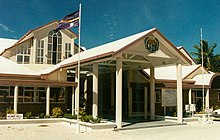
The president of Nauru is Lionel Aingimea, who heads a 19-member unicameral parliament. The country is a member of the United Nations, the Commonwealth of Nations, the Asian Development Bank and the Pacific Islands Forum. Nauru also participates in the Commonwealth and Olympic Games. Recently Nauru became a member country of the International Renewable Energy Agency (IRENA). The Republic of Nauru became the 189th member of the International Monetary Fund in April 2016.
Nauru is a republic with a parliamentary system of government.[48] The president is both head of state and head of government and is dependent on parliamentary confidence to remain president. A 19-member unicameral parliament is elected every three years.[62] The parliament elects the president from its members, and the president appoints a cabinet of five to six members.[63]
Nauru does not have any formal structure for political parties, and candidates typically stand for office as independents; fifteen of the 19 members of the current Parliament are independents. Four parties that have been active in Nauruan politics are the Nauru Party, the Democratic Party, Nauru First and the Centre Party. However, alliances within the government are often formed based on of extended family ties rather than party affiliation.[64]
From 1992 to 1999, Nauru had a local government system known as the Nauru Island Council (NIC). This nine-member council was designed to provide municipal services. The NIC was dissolved in 1999 and all assets and liabilities became vested in the national government.[65] Land tenure on Nauru is unusual: all Nauruans have certain rights to all land on the island, which is owned by individuals and family groups. Government and corporate entities do not own any land, and they must enter into a lease arrangement with landowners to use land. Non-Nauruans cannot own land on the island.[13]
Nauru had 17 changes of administration between 1989 and 2003.[66] Bernard Dowiyogo died in office in March 2003 and Ludwig Scotty was elected as the president, later being re-elected to serve a full term in October 2004. Following a vote of no confidence on 19 December 2007, Scotty was replaced by Marcus Stephen. Stephen resigned in November 2011, and Freddie Pitcher became President. Sprent Dabwido then filed a motion of no confidence in Pitcher, resulting in him becoming president.[67][68] Following parliamentary elections in 2013, Baron Waqa was elected president.
Its Supreme Court, headed by the Chief Justice, is paramount on constitutional issues. Other cases can be appealed to the two-judge Appellate Court. Parliament cannot overturn court decision. Historically, Appellate Court rulings could be appealed to the High Court of Australia,[69][70] though this happened only rarely and the Australian court's appellate jurisdiction ended entirely on 12 March 2018 after the Government of Nauru unilaterally ended the arrangement.[71][72][73] Lower courts consist of the District Court and the Family Court, both of which are headed by a Resident Magistrate, who also is the Registrar of the Supreme Court. There are two other quasi-courts: the Public Service Appeal Board and the Police Appeal Board, both of which are presided over by the Chief Justice.[2]
Foreign relations
Following independence in 1968, Nauru joined the Commonwealth of Nations as a Special Member; it became a full member in 2000.[74] The country was admitted to the Asian Development Bank in 1991 and the United Nations in 1999.[75] Nauru is a member of the Pacific Islands Forum, the South Pacific Regional Environment Programme, the South Pacific Commission, and the South Pacific Applied Geoscience Commission.[76] The US Atmospheric Radiation Measurement program operates a climate-monitoring facility on the island.[77]
Nauru
Nauru has used its position as a member of the United Nations to gain financial support from both
In 2008, Nauru recognised Kosovo as an independent country, and in 2009 Nauru became the fourth country, after Russia, Nicaragua, and Venezuela, to recognise Abkhazia, a breakaway region of Georgia. Russia was reported to be giving Nauru US$50 million in humanitarian aid as a result of this recognition.[78] On 15 July 2008, the Nauruan government announced a port refurbishment programme, financed with US$9 million of development aid received from Russia. The Nauru government claims this aid is not related to its recognising Abkhazia and South Ossetia.[82]

A significant portion of Nauru's income has been in the form of aid from Australia. In 2001, the MV Tampa, a Norwegian ship that had rescued 438 refugees from a stranded 20-metre-long boat, was seeking to dock in Australia. In what became known as the Tampa affair, the ship was refused entry and boarded by Australian troops. The refugees were eventually loaded onto Royal Australian Navy vessel HMAS Manoora and taken to Nauru to be held in detention facilities which later became part of the Howard government's Pacific Solution. Nauru operated two detention centres known as State House and Topside for these refugees in exchange for Australian aid.[83] By November 2005, only two refugees, Mohammed Sagar and Muhammad Faisal remained on Nauru from those first sent there in 2001,[84] with Sagar finally resettling in early 2007. The Australian government sent further groups of asylum-seekers to Nauru in late 2006 and early 2007.[85] The refugee centre was closed in 2008,[2] but, following the Australian government's re-adoption of the Pacific Solution in August 2012, it has re-opened it.[86]
In March 2017, at the 34th regular session of the UN Human Rights Council, Vanuatu made a joint statement on behalf of Nauru and some other Pacific nations raising human rights violations in the Western New Guinea, which has been occupied by Indonesia since 1963,[87] and requested that the UN High Commissioner for Human Rights produced a report.[88][89] Indonesia rejected allegations.[89] More than 100,000 Papuans have died during a 50-year Papua conflict.[90]
Amnesty International has since described the conditions of the refugees of war living in Nauru, as a "horror",[91][92] with reports of children as young as eight attempting suicide and engaging in acts of self-harm.[93] In 2018, the situation gained attention as a "mental health crisis", with an estimated thirty children suffering from traumatic withdrawal syndrome, also known as resignation syndrome. The condition is a deteriorating psychiatric condition wherein the sufferer can eventually become unresponsive and their body can begin to shut down. This condition has also been observed in other groups of asylum seekers.[93][94]
Administrative divisions

Nauru is divided into fourteen administrative districts which are grouped into
|
Economy

The Nauruan economy peaked in the mid-1970s to early-1980s,
Because of mismanagement, the trust's fixed and
The value of the trust is estimated to have shrunk from A$1.3 billion in 1991 to A$138 million in 2002.[103] Nauru currently lacks money to perform many of the basic functions of government; for example, the National Bank of Nauru is insolvent. The CIA World Factbook estimated a GDP per capita of US$5,000 in 2005.[1] The Asian Development Bank 2007 economic report on Nauru estimated GDP per capita at US$2,400 to US$2,715.[96] The United Nations (2013) estimates the GDP per capita to 15,211 and ranks it 51 on its GDP per capita country list.
There are no personal taxes in Nauru. The unemployment rate is estimated to be 23 percent, and of those who have jobs, the government employs 95 per cent.[1][104] The Asian Development Bank notes that, although the administration has a strong public mandate to implement economic reforms, in the absence of an alternative to phosphate mining, the medium-term outlook is for continued dependence on external assistance.[103] Tourism is not a major contributor to the economy.[105]
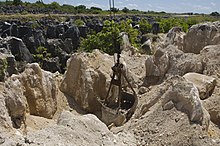
In the 1990s, Nauru became a
From 2001 to 2007, the
In July 2017 the Organisation for Economic Co-operation and Development (OECD) upgraded its rating of Nauru's standards of tax transparency. Previously Nauru had been listed alongside fourteen other countries that had failed to show that they could comply with international tax transparency standards and regulations. The OECD subsequently put Nauru through a fast-tracked compliance process and the country was given a "largely compliant" rating.[110]
The Nauru 2017–2018 budget, delivered by Minister for Finance David Adeang, forecasted A$128.7 million in revenues and A$128.6 million in expenditures and projected modest economic growth for the nation over the next two years.[111]
Population
Demographics
Nauru had 12,511 residents as of July 2021, making it the second smallest sovereign state after Vatican City.[112][113] The population was previously larger, but in 2006 1,500 people left the island during a repatriation of immigrant workers from Kiribati and Tuvalu. The repatriation was motivated by large force reductions in phosphate mining.[96] Nauru is the least populous country in Oceania.
Nauru is one of the most Westernized countries in the South Pacific.[114]
Ethnic groups
Fifty-eight percent of people in Nauru are ethnically Nauruan, 26 percent are other Pacific Islander, 8 percent are European, and 8 percent are Han Chinese.[1] Nauruans descended from Polynesian and Micronesian seafarers. Two of the 12 original tribal groups became extinct in the 20th century.[2]
Languages
The official language of Nauru is Nauruan, a distinct Micronesian language, which is spoken by 96 per cent of ethnic Nauruans at home.[96] English is widely spoken and is the language of government and commerce, as Nauruan is not used outside of the country.[1][2]
Religion
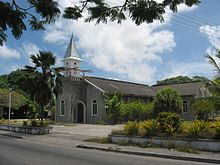
The main
Culture
Angam Day, held on 26 October, celebrates the recovery of the Nauruan population after the two World Wars and the 1920 influenza epidemic.[116] The displacement of the indigenous culture by colonial and contemporary Western influences is significant.[117] Few of the old customs have been preserved, but some forms of traditional music, arts and crafts, and fishing are still practised.[118]
Media
There are no daily news publications on Nauru, although there is one fortnightly publication, Mwinen Ko. There is a state-owned television station, Nauru Television (NTV), which broadcasts programs from New Zealand and Australia, and a state-owned non-commercial radio station, Radio Nauru, which carries programs from Radio Australia and the BBC.[119]
Sport
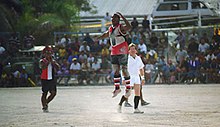
Australian rules football is the most popular sport in Nauru—it and weightlifting are considered the country's national sports. There is an Australian rules football league with eight teams.[120] Other sports popular in Nauru include volleyball, netball, fishing and tennis. Nauru participates in the Commonwealth Games and has participated in the Summer Olympic Games in weightlifting and judo.[121]
Rugby sevens popularity has increased over the last two years, so much so that they have a national team.
Nauru competed in the 2015 Oceania Sevens Championship in New Zealand.
Holidays
Independence Day is celebrated on 31 January.[122]
Public services
Education
Literacy on Nauru is 96 per cent. Education is compulsory for children from six to sixteen years old, and two more non-compulsory years are offered (years 11 and 12).[123] The island has three primary schools and two secondary schools, the latter being Nauru College and Nauru Secondary School.[124] There is a campus of the University of the South Pacific on Nauru. Before this campus was built in 1987, students would study either by distance or abroad.[125] Since 2011, the University of New England, Australia has established a presence on the island with around 30 Nauruan teachers studying for an associate degree in education. These students will continue onto the degree to complete their studies.[126] This project is led by Associate Professor Pep Serow and funded by the Australian Department of Foreign Affairs and Trade.
The previous community public library was destroyed in a fire. As of 1999[update] a new one had not yet been built, and no bookmobile services are available as of that year. Sites with libraries include the University of the South Pacific campus, Nauru Secondary, Kayser College, and Aiwo Primary.[127] The Nauru Community Library is in the new University of the South Pacific Nauru Campus building, which was officially opened in May 2018.
Health
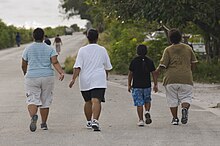
Life expectancy on Nauru in 2009 was 60.6 years for males and 68.0 years for females.[129]
By measure of
Nauru has the world's highest level of
Transport
Air

The island is solely served by Nauru International Airport. Passenger service is provided by Nauru Airlines with Pacific Air Express also providing cargo service. Flights operate five days a week to well connected airports such as Brisbane and Nadi.[132]
See also
Notes
References
Citations
- ^ a b c d e f g h i Central Intelligence Agency (2015). "Nauru". The World Factbook. Archived from the original on 17 September 2008. Retrieved 8 June 2015.
- ^ a b c d e f g h i j k l m n "Background Note: Nauru". State Department Bureau of East Asian and Pacific Affairs. September 2005. Retrieved 11 May 2006.
- ^ "National Report on Population ad Housing" (PDF). Nauru Bureau of Statistics. Archived from the original (PDF) on 24 September 2015. Retrieved 9 June 2015.
- ^ a b c d "Report for Selected Countries and Subjects". www.imf.org.
- Cambridge English Dictionary. Cambridge University Press. Archivedfrom the original on 17 February 2015. Retrieved 16 February 2015.
- ^ "Nauru – Definition, pictures, pronunciation and usage notes". Oxford Advanced Learner's Dictionary. Oxford University Press. Archived from the original on 2 January 2015. Retrieved 2 January 2015.
- Encyclopedia Britannica. Retrieved 2 September 2019.
- ^ Hogan, C Michael (2011). "Phosphate". Encyclopedia of Earth. National Council for Science and the Environment. Archived from the original on 25 October 2012. Retrieved 17 June 2012.
- ^ Hitt, Jack. "The Billion-Dollar Shack". The New York Times. Archived from the original on 16 January 2018. Retrieved 29 January 2018.
- ^ "Pacific correspondent Mike Field". Radio New Zealand. 18 June 2015. Archived from the original on 10 December 2015. Retrieved 8 December 2015.
- ^ "Nauru's former chief justice predicts legal break down". Special Broadcasting Service. Archived from the original on 10 December 2015. Retrieved 8 December 2015.
- ^ Ben Doherty. "This is Abyan's story, and it is Australia's story". The Guardian. Archived from the original on 26 February 2017. Retrieved 12 December 2016.
- ^ a b c d Nauru Department of Economic Development and Environment (2003). "First National Report to the United Nations Convention to Combat Desertification" (PDF). United Nations. Archived from the original (PDF) on 22 July 2011. Retrieved 25 June 2012.
- .
- ^ Pollock, Nancy J (1995). "5: Social Fattening Patterns in the Pacific—the Positive Side of Obesity. A Nauru Case Study". In De Garine, I (ed.). Social Aspects of Obesity. Routledge. pp. 87–111.
- S2CID 40606338.
- ISBN 978-1-4381-1913-7.
- ^ ISBN 0-522-84302-6.
- ^ OCLC 3444055.
- ISBN 086784471X
- ^ Langdon, p.182
- .
- ^ Reyes, Ramon E. Jr (1996). "Nauru v. Australia". New York Law School Journal of International and Comparative Law. 16 (1–2). Archived from the original on 27 February 2017. Retrieved 14 April 2019.
- ^ a b c d e "Commonwealth and Colonial Law" by Kenneth Roberts-Wray, London, Stevens, 1966. p. 884
- ^ .
- ^ ISBN 978-0-520-05817-0.
- ^ Ellis, AF (1935). Ocean Island and Nauru – their story. Angus and Robertson Limited. pp. 29–39.
- ^ Hartleben, A (1895). Deutsche Rundschau für Geographie und Statistik. p. 429.
- ^ .
- JSTOR 3147015.
- ^ a b c Cmd. 1202
- S2CID 21563401.
- .
- ISBN 978-1-4357-5760-8.
- ^ a b Bogart, Charles H (November 2008). "Death off Nauru" (PDF). CDSG Newsletter: 8–9. Archived from the original (PDF) on 12 October 2013. Retrieved 16 June 2012.
- ^ a b Haden, JD (2000). "Nauru: a middle ground in World War II". Pacific Magazine. Archived from the original on 8 February 2012. Retrieved 16 June 2012.
- ^ Takizawa, Akira; Alsleben, Allan (1999–2000). "Japanese garrisons on the by-passed Pacific Islands 1944–1945". Forgotten Campaign: The Dutch East Indies Campaign 1941–1942. Archived from the original on 6 January 2016.
- ^ The Times, 14 September 1945
- ^ "Nauru Occupied by Australians; Jap Garrison and Natives Starving". The Argus. 15 September 1945. Retrieved 30 December 2010.
- ISBN 0-7333-0485-0.
- ^ JSTOR 2203821. Archived from the originalon 11 May 2011. Retrieved 11 October 2008.
- ^ Cmd. 7290
- ^ "Island Purchase For Nauruans". The Canberra Times. Vol. 38, no. 10, 840. Australian Capital Territory, Australia. 6 May 1964. p. 5. Retrieved 1 April 2019 – via National Library of Australia.
- ^ "Nauruans Likely To Settle Curtis Island". The Canberra Times. Vol. 37, no. 10, 549. Australian Capital Territory, Australia. 30 May 1963. p. 9. Retrieved 1 April 2019 – via National Library of Australia.
- ^ McAdam, Jane (15 August 2016). "How the entire nation of Nauru almost moved to Queensland". The Conversation. Archived from the original on 1 April 2019. Retrieved 1 April 2019.
- ^ "Lack of Sovereignty 'Disappoints' Nauruans". The Canberra Times. Vol. 37, no. 10, 554. Australian Capital Territory, Australia. 5 June 1963. p. 45. Retrieved 1 April 2019 – via National Library of Australia.
- ^ "Nauru not to take Curtis Is". The Canberra Times. Vol. 38, no. 10, 930. Australian Capital Territory, Australia. 21 August 1964. p. 3. Retrieved 1 April 2019 – via National Library of Australia.
- ^ .
- ^ Squires, Nick (15 March 2008). "Nauru seeks to regain lost fortunes". BBC News Online. Archived from the original on 20 March 2008. Retrieved 16 March 2008.
- ^ a b c d Watanabe, Anna (16 September 2018). "From economic haven to refugee 'hell'". Kyodo News. Archived from the original on 17 September 2018. Retrieved 17 September 2018.
- ISBN 978-92-1-070936-1.
- ^ Google Map Developers. "Distance Finder". Archived from the original on 22 August 2017. Retrieved 9 April 2017.
{{cite web}}:|author1=has generic name (help) - ^ Thaman, RR; Hassall, DC. "Nauru: National Environmental Management Strategy and National Environmental Action Plan" (PDF). South Pacific Regional Environment Programme. p. 234. Archived (PDF) from the original on 11 May 2012. Retrieved 18 June 2012.
- ISBN 978-0-444-81520-0.
- ^ "Climate Change – Response" (PDF). First National Communication. United Nations Framework Convention on Climate Change. 1999. Archived (PDF) from the original on 6 August 2009. Retrieved 9 September 2009.
- ISBN 978-92-1-070936-1.
- ^ "Pacific Climate Change Science Program" (PDF). Government of Australia. Archived from the original (PDF) on 27 February 2012. Retrieved 10 June 2012.
- ^ "Yaren | district, Nauru". Encyclopedia Britannica. Retrieved 2 September 2019.
- ^ "NAURU Information on Government, People, History, Economy, Environment, Development". Archived from the original on 27 July 2013.
- ^ BirdLife International. "Important Bird Areas in Nauru". Secretariat of the Pacific Regional Environmental Programme. Archived from the original on 13 January 2013. Retrieved 18 June 2012.
- ^ "Nauru Ecotourism Tours – Sustainable Tourism & Conservation Laws". Archived from the original on 27 September 2012. Retrieved 11 September 2012.
- ^ Matau, Robert (6 June 2013) "President Dabwido gives it another go" Archived 26 September 2013 at the Wayback Machine . Islands Business.
- S2CID 154374242.
- S2CID 154687315.
- ^ Hassell, Graham; Tipu, Feue (May 2008). "Local Government in the South Pacific Islands". Commonwealth Journal of Local Governance. 1 (1): 6–30. Archived from the original on 26 May 2010. Retrieved 30 January 2011.
- ^ Australian Department of Foreign Affairs and Trade. November 2005. Archivedfrom the original on 6 October 2014. Retrieved 2 May 2006.
- S2CID 155082551.
- ^ "Nauru profile". BBC News Online. 24 October 2011. Archived from the original on 11 June 2012. Retrieved 17 June 2012.
- ^ "Nauru (High Court Appeals) Act (Australia) 1976". Australian Legal Information Institute. Archived from the original on 1 October 2006. Retrieved 7 August 2006.
- .
- The University of Melbourne. Archivedfrom the original on 2 April 2018. Retrieved 2 April 2018.
- ^ Clarke, Melissa (2 April 2018). "Justice in Nauru curtailed as Government abolishes appeal system". ABC News. Archived from the original on 2 April 2018. Retrieved 2 April 2018.
- ^ Wahlquist, Calla (2 April 2018). "Fears for asylum seekers as Nauru moves to cut ties to Australia's high court". The Guardian. Archived from the original on 1 April 2018. Retrieved 2 April 2018.
- ^ "Republic of Nauru Permanent Mission to the United Nations". United Nations. Archived from the original on 18 August 2006. Retrieved 10 May 2006.
- ^ "Nauru in the Commonwealth". Commonwealth of Nations. Archived from the original on 23 November 2010. Retrieved 18 June 2012.
- ^ "Nauru (04/08)". US State Department. 2008. Retrieved 17 June 2012.
- .
- ^ a b Harding, Luke (14 December 2009). "Tiny Nauru struts world stage by recognising breakaway republics". The Guardian. Archived from the original on 17 December 2009. Retrieved 22 June 2010.
- ^ Su, Joy (15 May 2005). "Nauru switches its allegiance back to Taiwan from China". Taipei Times. Archived from the original on 2 October 2012. Retrieved 18 June 2012.
- ^ "China officially severs diplomatic ties with Nauru". Asia Africa Intelligence Wire. 31 May 2005. Archived from the original on 11 May 2013. Retrieved 18 June 2012.
- ^ "Chinese Embassy in Nauru". Gov.cn. 18 January 2006. Archived from the original on 25 August 2012. Retrieved 18 June 2012.
- ^ "Nauru expects to earn more from exports after port upgrade with Russian aid". Radio New Zealand International. 15 July 2010. Archived from the original on 4 September 2011. Retrieved 15 July 2010.
- from the original on 8 December 2012. Retrieved 18 June 2012.
- ^ Gordon, M (5 November 2005). "Nauru's last two asylum seekers feel the pain". The Age. Archived from the original on 4 June 2008. Retrieved 8 May 2006.
- ^ "Nauru detention centre costs $2m per month". ABC News. 12 February 2007. Archived from the original on 11 May 2013. Retrieved 12 February 2007.
- ^ a b "Asylum bill passes parliament". The Daily Telegraph. 16 August 2012. Retrieved 18 August 2012.
- ^ "Freedom of the press in Indonesian-occupied West Papua". The Guardian. 22 July 2019.
- ^ Fox, Liam (2 March 2017). "Pacific nations call for UN investigations into alleged Indonesian rights abuses in West Papua". ABC News.
- ^ a b "Pacific nations want UN to investigate Indonesia on West Papua". SBS News. 7 March 2017.
- ^ "Goodbye Indonesia". Al-Jazeera. 31 January 2013.
- ^ "'It's better to die from one bullet than being slowly killed every day' – refugees forsaken on Nauru". Amnesty International. Archived from the original on 8 August 2016. Retrieved 6 August 2016.
- ^ "Life for asylum seekers in Australia's 'Pacific Gulag' on Nauru". South China Morning Post (SCMP). Agence France-Presse (AFP). 11 September 2018. Archived from the original on 20 September 2018. Retrieved 20 September 2018.
- ^ a b Harrison, Virginia. "Nauru refugees: The island where children have given up on life". BBC. BBC. Archived from the original on 17 February 2019. Retrieved 16 February 2019.
- ^ "Five years on Nauru". Reveal. 16 February 2019. Archived from the original on 31 March 2019. Retrieved 31 March 2019.
- ^ "Nauru—The population of the districts of the Republic of Nauru". City Population. 2011. Archived from the original on 23 September 2015. Retrieved 10 June 2015.
- ^ a b c d "Country Economic Report: Nauru" (PDF). Asian Development Bank. p. 6. Archived from the original (PDF) on 7 June 2011. Retrieved 20 June 2012.
- ^ "Big tasks for a small island". BBC News Online. Archived from the original on 13 August 2006. Retrieved 10 May 2006.
- ^ Seneviratne, Kalinga (26 May 1999). "Nauru turns to dust". Asia Times. Archived from the original on 18 June 2012. Retrieved 19 June 2012.
- ^ Mellor, William (1 June 2004). "GE Poised to Bankrupt Nauru, Island Stained by Money-Laundering". Bloomberg. Archived from the original on 9 March 2013. Retrieved 19 June 2012.
- Sydney Morning Herald. Archivedfrom the original on 3 November 2012. Retrieved 19 June 2012.
- ^ "Receivers take over Nauru House". The Age. 18 April 2004. Archived from the original on 13 February 2016. Retrieved 19 June 2012.
- ^ "Nauru sells last remaining property asset in Melbourne". RNZ Pacific. 9 April 2005. Archived from the original on 20 September 2018. Retrieved 20 September 2018.
- ^ a b "Asian Development Outlook 2005 – Nauru". Asian Development Bank. 2005. Archived from the original on 7 June 2011. Retrieved 2 May 2006.
- ^ "Paradise well and truly lost". The Economist. 20 December 2001. Archived from the original on 30 November 2006. Retrieved 2 May 2006.
- ^ "Nauru". Pacific Islands Trade and Investment Commission. Archived from the original on 21 July 2008. Retrieved 19 June 2012.
- ^ "The Billion Dollar Shack". The New York Times. 10 December 2000. Archived from the original on 18 November 2011. Retrieved 19 July 2011.
- ^ "Nauru de-listed" (PDF). FATF. 13 October 2005. Archived from the original (PDF) on 30 December 2005. Retrieved 11 May 2006.
- ^ Topsfield, Hewel (11 December 2007). "Nauru fears gap when camps close". The Age. Archived from the original on 23 October 2012. Retrieved 19 June 2012.
- ^ "Nauru 'hit' by detention centre closure". The Age. 7 February 2008. Retrieved 19 June 2012.
- ^ "Nauru gets an OECD upgrade". 12 July 2017. Archived from the original on 6 August 2017. Retrieved 6 August 2017.
- ^ "Modest economic growth forecast for Nauru". Loop Pacific. 12 June 2017. Archived from the original on 17 September 2018. Retrieved 17 September 2018.
- ^ "World Population Prospects 2022". United Nations Department of Economic and Social Affairs, Population Division. Retrieved 17 July 2022.
- ^ "World Population Prospects 2022: Demographic indicators by region, subregion and country, annually for 1950-2100" (XSLX) ("Total Population, as of 1 July (thousands)"). United Nations Department of Economic and Social Affairs, Population Division. Retrieved 17 July 2022.
- ^ "Yaren | district, Nauru". Encyclopedia Britannica. Retrieved 2 September 2019.
- ^ "International Religious Freedom Report 2003 – Nauru". US Department of State. 2003. Retrieved 2 May 2005.
- ^ "Nauru Celebrates Angam Day". United Nations. Archived from the original on 21 October 2004. Retrieved 19 June 2012.
- ^ Nazzal, Mary (April 2005). "Nauru: an environment destroyed and international law" (PDF). lawanddevelopment.org. Archived (PDF) from the original on 19 October 2012. Retrieved 19 June 2012.
- ^ "Culture of Nauru". Republic of Nauru. Archived from the original on 4 January 2013. Retrieved 19 June 2012.
- ^ "Country Profile: Nauru". BBC News Online. Archived from the original on 15 June 2006. Retrieved 2 May 2006.
- ^ "Nauru Australian Football Association". Australian Football League. Archived from the original on 31 December 2008. Retrieved 19 June 2012.
- ^ "Nauru Olympic Committee History". Nauru Olympic Committee. Archived from the original on 26 July 2012. Retrieved 20 June 2012.
- ISBN 9781420036640. Archivedfrom the original on 15 February 2017. Retrieved 30 January 2017.
- ^ Waqa, B (1999). "UNESCO Education for all Assessment Country report 1999 Country: Nauru". Archived from the original on 25 May 2006. Retrieved 2 May 2006.
- ^ "Schools Archived 5 July 2018 at the Wayback Machine." Government of Nauru. Retrieved on 5 June 2018.
- ^ "USP Nauru Campus". University of the South Pacific. Archived from the original on 20 June 2012. Retrieved 19 June 2012.
- ^ "Nauru Teacher Education Project". Archived from the original on 8 December 2015. Retrieved 5 December 2015.
- .
- ^ a b c "Fat of the land: Nauru tops obesity league". The Independent. 26 December 2010. Archived from the original on 18 June 2012. Retrieved 19 June 2012.
- ^ a b "Nauru". World health report 2005. World Health Organization. Archived from the original on 18 April 2006. Retrieved 2 May 2006.
- Asahi Shimbun. Archived from the originalon 28 May 2014. Retrieved 23 January 2013.
- ^ King, H; Rewers M (1993). "Diabetes in adults is now a Third World problem". Ethnicity & Disease. 3: S67–74.
- ^ "Flight schedule for Nauru Airlines". Archived from the original on 28 February 2019. Retrieved 31 January 2019.
Sources
 This article incorporates public domain material from U.S. Relations With Nauru. United States Department of State.
This article incorporates public domain material from U.S. Relations With Nauru. United States Department of State. This article incorporates public domain material from The World Factbook. CIA.
This article incorporates public domain material from The World Factbook. CIA.
Further reading
- Gowdy, John M.; McDaniel, Carl N. (2000). Paradise for Sale: A Parable of Nature. University of California Press. ISBN 978-0-520-22229-8.
- Williams, Maslyn; Macdonald, Barrie (1985). The Phosphateers. Melbourne University Press. ISBN 0-522-84302-6.
External links
- Government of Nauru
- Nauru National Tourism Office
- "Nauru". The World Factbook (2024 ed.). Central Intelligence Agency.
- Googletheninja/sandbox at Curlie
 Wikimedia Atlas of Nauru
Wikimedia Atlas of Nauru- Nauru from UCB Libraries GovPubs
- Nauru profile from the BBC News Online
Template:Featured article is only for Wikipedia:Featured articles.





